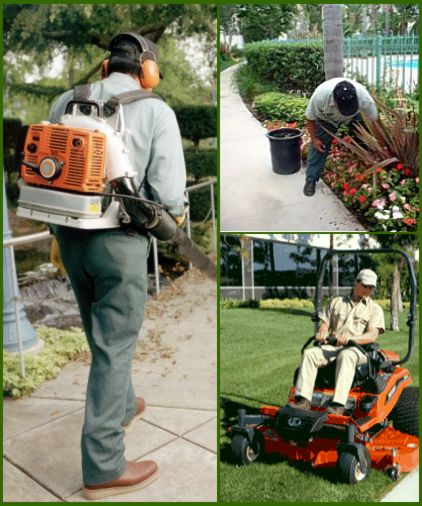
by Sheila Dunning | Jan 13, 2020
 No previous experience or accreditation it required to be a landscaper in the state of Florida. So when homeowners are searching for service providers, it is important that they question potential companies about their skills. One good measure is completion of voluntary certifications such as the Florida Nursery, Growers and Landscape Association (FNGLA) Certified Horticulture Professional (FCHP). The FCHP program has been the industry’s standard for measuring horticulture and landscape knowledge since 1984. The training is also useful for property managers, homeowner associations and retail garden center employees, or anyone that wants to know more about Florida’s plants and their care.
No previous experience or accreditation it required to be a landscaper in the state of Florida. So when homeowners are searching for service providers, it is important that they question potential companies about their skills. One good measure is completion of voluntary certifications such as the Florida Nursery, Growers and Landscape Association (FNGLA) Certified Horticulture Professional (FCHP). The FCHP program has been the industry’s standard for measuring horticulture and landscape knowledge since 1984. The training is also useful for property managers, homeowner associations and retail garden center employees, or anyone that wants to know more about Florida’s plants and their care.
Plants are complex and variable living things that range from microscopic to the largest of living organisms. With steady population growth in the state of Florida, environmental damage risks created by the use of improper products and practices has continually risen. State and federal natural resource protection agencies have restricted certain horticultural practices, as well as, fertilizer and pesticide application. It takes scientific knowledge to maintain lawns and landscapes, not just a “green thumb” in order to keep plants healthy while reducing contamination to the soil, air and water that we all need.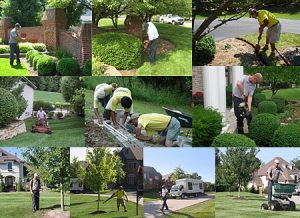
The Florida Certified Horticulture Professional training covers 16 areas, including identification, fertilization, irrigation, pest management, safety and business practices. Lecture and hands-on activities are utilized at each session. The 70-hour course will enhance anyone’s knowledge and will provide the basis for professionals to deliver a skilled service to clientele.
If you are a green industry worker or a concerned citizen interested in attending a FCHP preparatory course, there is an opportunity here in Crestview. Beginning Thursday, January 16, 2020 and continuing for 10 weeks to March 19, 2020, the Okaloosa County Extension office will be providing training for $175, which included the newest hard copy manual. Contact Sheila Dunning, 850-689-5850, sdunning@ufl.edu for more information.
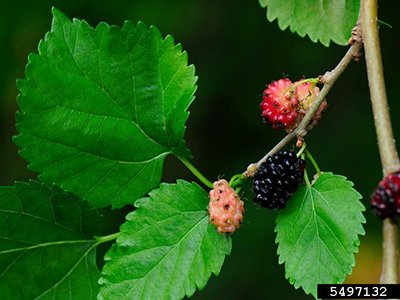
by Sheila Dunning | Dec 4, 2019
“Here we go ‘round the mulberry bush” is still sung by small children today. There are lots of different versions of the lyrics. But each usually describes a daily or weekly task list. In fact, the rhyme began in 1840 as a cadence for female prisoners exercising at the Wakefield Prison in England. There happened to be a Black Mulberry (Morus nigra) growing in the yard. Black Mulberry is a slow-growing short tree, so as a young tree it appears bushy.
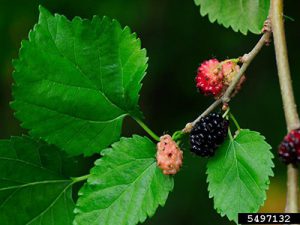 Red Mulberry (Morus rubra) is the native Florida species. It tends to grow more upright, but is still a small tree. Additionally, there are White (Morus alba) and Pakistan (Morus macroura) , as well as, many hybrid Mulberries that will grow in the Florida panhandle. White Mulberry is a fast growing tall tree that is so aggressive that it is classified as an invasive species. It can rapidly seed natural areas and become the dominant species. But, the Pakistan Mulberry is a small tree that develops a characteristic crooked, gnarled trunk and a large fruit. It can be pruned as a bush easily.
Red Mulberry (Morus rubra) is the native Florida species. It tends to grow more upright, but is still a small tree. Additionally, there are White (Morus alba) and Pakistan (Morus macroura) , as well as, many hybrid Mulberries that will grow in the Florida panhandle. White Mulberry is a fast growing tall tree that is so aggressive that it is classified as an invasive species. It can rapidly seed natural areas and become the dominant species. But, the Pakistan Mulberry is a small tree that develops a characteristic crooked, gnarled trunk and a large fruit. It can be pruned as a bush easily.
Growing the mulberry bush can add a unique winter feature to the landscape while producing food for the birds. Yet, the plant is short enough that the fruit can be harvested without having to shake the tree and gather up the fruit from the ground before the birds get all the berries.
Mulberries are self-pollinating and only require about 400 chill hours. A chill hour is each hour that the temperature remain between 32 and 45 degrees Fahrenheit. After 400 cumulative hours the plant is able to flower. The fruit matures in the late spring to early summer. The birds will be sure to notify everyone when it’s time. Pakistan Mulberry can produce 4 inch long berries.
Mulberries will perform well if planted this winter. Plan on pruning them back each year if the bush effect is desired. It can take a year or two to get fully rooted. Don’t be surprised to see some fruit drop off prematurely as the tree/bush gets established. Also, pay attention to where the mulberry is installed. Windy spots will knock off fruit. What birds eat, they deposit. Mulberries will stain the surfaces they land on. If the fruit is walked through, the staining can be moved to indoor surfaces.
When picking fruit don’t forget the gloves unless dark stained fingers is the new look you’re trying to create.
For more information on mulberries: http://gardeningsolutions.ifas.ufl.edu/plants/trees-and-shrubs/trees/mulberry.html

by Sheila Dunning | Sep 7, 2019
“There are these weeds spreading all over my yard. They have little round leaves that are real close to the ground and creep in every direction. I keep trying to get rid of them by mowing my grass shorter, but they are killing my grass. What are they and how do I get rid of them?” Here at the Extension office, this is a conversation I have had nearly daily for the past month. We are here to help with identification and control of many landscape problems, including weeds.
However, my first word of advice is to change the mowing practice. Short, spreading weeds cannot be mowed out. You need to do just the opposite. Mowing as high as possible (3-4”) will help to reduce weeds by shading them out, therefore, reducing their spread.
In every instance, the weeds have been common lespedeza (Kummerowia striata (Thunb.) Schind syn. Lespedeza striata) and/or prostrate spurge (Euphorbia maculata syn. Chamaesyce maculata). Both grow close to the ground with a spreading habit. Both have small, rounded leaves and produce small, light-colored flowers. But, if you look close, there are significant differences that will help with identification.
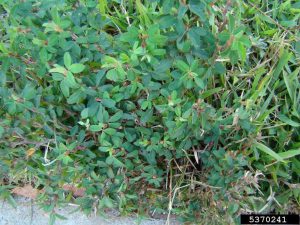 Common lespedeza, also known as Japanese clover, is prostrate summer annual that forms 15-18 inch patches. The stems are wiry. It has dark green trifoliate
Common lespedeza, also known as Japanese clover, is prostrate summer annual that forms 15-18 inch patches. The stems are wiry. It has dark green trifoliate 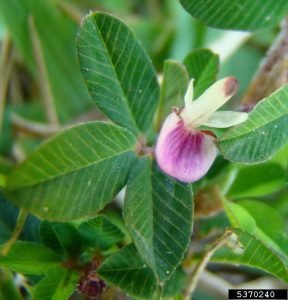 (arranged in threes) leaves with three oblong, smooth leaflets. Leaflets have parallel veins nearly at right angles to a prominent mid-vein. Its leaves have smooth edges and a short spur at the tip of each leaflet. Flowers appear in late summer with small pink to purple, single flowers found in leaf axils on most of the nodes of the main stems. As common lespedeza matures, the stems harden and become woody.
(arranged in threes) leaves with three oblong, smooth leaflets. Leaflets have parallel veins nearly at right angles to a prominent mid-vein. Its leaves have smooth edges and a short spur at the tip of each leaflet. Flowers appear in late summer with small pink to purple, single flowers found in leaf axils on most of the nodes of the main stems. As common lespedeza matures, the stems harden and become woody.
Prostrate spurge is a summer annual broadleaf weed that spreads by seed. The leaves are oval in shape, small, and opposite along the stem. As it matures, a red spot may form in the center of the leaf, earning it the common name spotted spurge. Another distinct characteristic is the stem contains a milky sap that oozes when the stem is broken. Light pink to white-colored flowers appear from early-summer through the fall.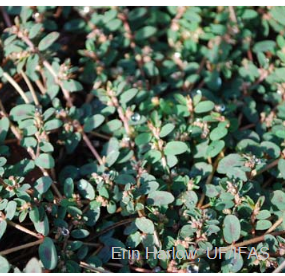
Both are annual,broadleaf weeds, so there are several post-emergent herbicides available to kill the ones present. Don’t forget the pre-emergent herbicide application in late winter though. These weeds can drop plenty of seed. The importance of knowing which weed you have is more about the message they are trying to send you. These weeds can indicate other issues that may be part of the reason the grass is thinning and allowing the weeds to take over in the first place.
Common lespedeza is a legume. It thrives when water is plentiful and soil nutrients are low. If this is the weed “taking over” your yard, you need to get a soil test and evaluate your watering habits. Improving fertility and reducing soil moisture will naturally weaken common lespedeza.
If your thin patches of declining grass are being replaced with spurge, it may be time to submit a sample for a nematode assay. Research has shown that spurge is a weed that can thrive with high populations of nematodes. Turfgrass species are easily harmed by nematodes (microscopic roundworms that imbed into and on grass roots). If the assay indicates harmful population levels, unfortunately there are few options for reduction of the nematodes. However, several ornamental plants are tolerant. So, you may need to consider creating a landscape bed area rather than continuing to battle poor-looking grass.
Weeds can serve as indicators to soil conditions that may need to be addressed. Learning to identify weeds may teach you more than just their names.
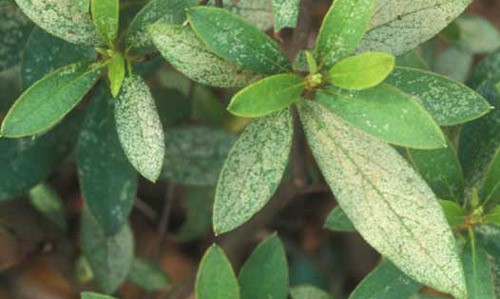
by Sheila Dunning | Aug 7, 2019
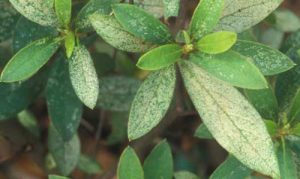
Damage caused by azalea lace bug, Stephanitis pyrioides (Scott), feeding. Photograph by James. L. Castner, University of Florida. Severely damaged leaves become heavily discolored and eventually dry or fall off. Symptoms may sometimes be confused with mite injury, but the presence of black varnish-like excrement, frequently with cast skins attached, suggest lace bug damage (Johnson and Lyon 1991).
You may be noticing the color disappearing from your azaleas right now. Do your azaleas look bleached out from a piercing-sucking insect. The culprit is probably azalea lace bug, Stephanitis pyrioides. This pest overwinters in eggs on the underside of infested leaves. Eggs hatch in late March and early April. The insect then passes through five nymphal instars before becoming an adult. It takes approximately one month for the insect to complete development from egg to adult and there are at least four generations per year. Valuable plants that are susceptible to lace bug damage should be inspected in the early spring for the presence of overwintering lace bug adults, eggs and newly-hatched nymphs. Inspect these plants every two weeks during the growing season for developing lace bug infestations.
Both adults and nymphs have piercing-sucking mouthparts and remove sap as they feed from the underside of the leaf. Lace bug damage to foliage detracts greatly from the plant’s beauty, reduces the plant’s ability to produce food, decreases plant vigor and causes the plant to be more susceptible to damage by other insects, diseases or unfavorable weather conditions. The azalea can become almost silver or bleached in appearance from the feeding lace bug damage.
However, lace bugs often go undetected until the infested plants show severe damage sometime into the summer. By then several generations of lace bugs have been weakening the plant. Inspecting early in the spring and simply washing them off the underside of the leaves can help to avoid damage later and the need for pesticides.
Adult lace bugs are flattened and rectangular in shape measuring 1/8 to 1/4 inch long. The area behind the head and the wing covers form a broadened, lace-like body covering. The wings are light amber to transparent in color. Lace bugs leave behind spiny black spots of frass (excrement).
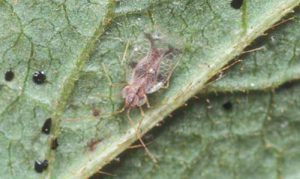
Adult azalea lace bug, Stephanitis pyrioides (Scott), and excrement. Photograph by James. L. Castner, University of Florida.
Lace bug nymphs are flat and oval in shape with spines projecting from their bodies in all directions. A lace bug nymph goes through five growth stages (instars) before becoming an adult. At each stage the nymph sheds its skin (molts) and these old skins often remain attached to the lower surface of infested leaves.
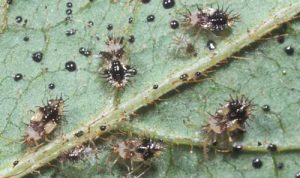
Nymphs of the azalea lace bug, Stephanitis pyrioides (Scott), with several cast skins and excrement. Photograph by James. L. Castner, University of Florida.
Azalea lace bug eggs are football-shaped and are transparent to cream colored. Lace bug eggs are found on the lower leaf surface, usually alongside or inserted into a leaf vein. Adult females secrete a varnish-like substance over the eggs that hardens into a scab-like protective covering.
Other plant species, such as lantana and sycamore, may have similar symptoms. But, realize that lace bugs are host specific. They feed on their favorite plant and won’t go to another plant species. However, the life cycle is similar. Be sure to clean up all the damaged leaves. That’s where the eggs will remain for the winter. Start next spring egg-free.
For more information go to: http://entomology.ifas.ufl.edu/creatures/orn/shrubs/azalea_lace_bug.htm
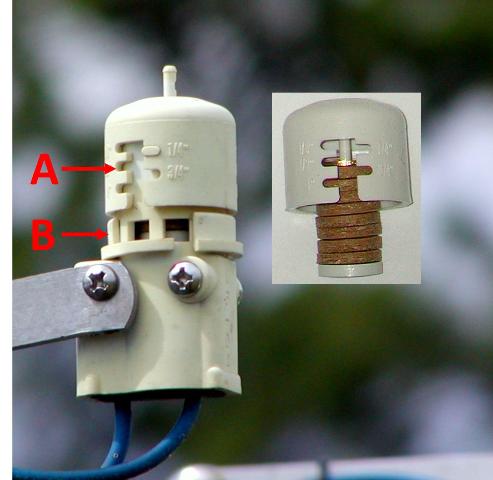
by Sheila Dunning | Jul 11, 2019
The Irrigation Association (IA) kicks off the official start of this year’s campaign on Tuesday, July 9, 2019. The initiative promotes the social, economic and environmental benefits of efficient irrigation technologies, products and services in landscape, turf and agricultural irrigation.
Irrigation (agricultural and turf/landscape) accounts for 65-70% of total freshwater use in the United States. According to the Environmental Protection Agency’s (EPA) WaterSense program, the average American family household uses more than 300 gallons of water per day; roughly 30% of this occurs outdoors. Efficient landscape irrigation systems and practices dramatically reduce water being lost or wasted.
The starting point for improving the efficiency of a home landscape sprinkler system is to calibrate each zone (http://ufdc.ufl.edu/IR00003389/00001) and make adjustments and repairs. That includes the rain shut-off device.
Florida is one of the few states with a rain sensor law. The most recent version of the statute (2010) states the following: “Any person who operates an automatic landscape irrigation system shall properly install, maintain, and operate technology that inhibits or interrupts operation of the system during periods of sufficient moisture.” (Florida Statute 373.62). Regardless of the water source or age of the system, all in-ground irrigation systems must be connected to a functioning rain sensor of some kind.

Expanding disk Rain Sensor
Expanded disk devices are the most popular rain sensor due to their low cost, ease of installation, and low maintenance. Traditionally, they are wired into the controller, but a wireless version allows for quicker installation and mounting up to 300 feet from the controller. These “mini-click” sensors contain disks made of cork that absorb rainfall and expand, triggering a pressure switch. The disk cover is rotated to adjust for the predetermined amount of rainfall required to trigger the switch. It should be set on ½ – ¾ inch, depending on soil type and rooting depth of irrigated plants. The switch continues to interrupt the scheduled controller as long as the disks are swollen. When the rain stops, the disks begin to dry out. Once they have contracted, the switch closes and the regularly scheduled irrigation cycle begins where it left off before the interruption. These small cork disks wear out in Florida’s heat and need to be replaced. By checking and repairing the sensor parts, the sprinkler system will operate much more efficiently. We have all seen irrigation systems running in pouring rain. Keep yours maintained to avoid this needless waste of water.
So, join the kids this summer. Go outside and play in the water. Turn on the sprinkler system and check it out. July is Smart Irrigation Month. Let’s see how efficient you can make your system and reduce the water waste in Florida.

 No previous experience or accreditation it required to be a landscaper in the state of Florida. So when homeowners are searching for service providers, it is important that they question potential companies about their skills. One good measure is completion of voluntary certifications such as the Florida Nursery, Growers and Landscape Association (FNGLA) Certified Horticulture Professional (FCHP). The FCHP program has been the industry’s standard for measuring horticulture and landscape knowledge since 1984. The training is also useful for property managers, homeowner associations and retail garden center employees, or anyone that wants to know more about Florida’s plants and their care.
No previous experience or accreditation it required to be a landscaper in the state of Florida. So when homeowners are searching for service providers, it is important that they question potential companies about their skills. One good measure is completion of voluntary certifications such as the Florida Nursery, Growers and Landscape Association (FNGLA) Certified Horticulture Professional (FCHP). The FCHP program has been the industry’s standard for measuring horticulture and landscape knowledge since 1984. The training is also useful for property managers, homeowner associations and retail garden center employees, or anyone that wants to know more about Florida’s plants and their care.












